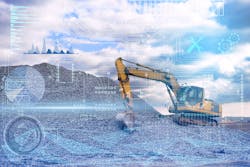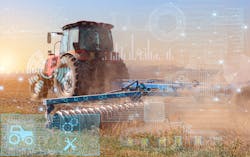Electro-Hydraulic Systems Realize Their Full Potential with IoT
Forward-looking organizations are adopting emerging technologies that provide access to critical data to create a competitive advantage. Companies are using live machine data to accelerate operational efficiency, differentiate their products, improve customer service and add new revenue streams to their businesses.
The implementation of sophisticated Internet of Things (IoT) technologies on mobile assets, which was once only possible on the factory floor, opens the door for numerous areas of improvement in electro-hydraulic systems. These systems are designed for machine applications in off-highway such as farming, construction, mining, forestry and other industries.
Benefits to the users of IoT-enabled mobile machines include enhanced productivity, reliability, safety, profitability and more. In addition, these technologies can become key differentiators for original equipment manufacturers (OEMs).
Connectivity and Convergence
New IoT technology methods of gathering data, along with new business intelligence models that analyze this data, are converging to offer critical insights into the operation of mobile assets. With widespread global access to 4G connectivity, and the onset of 5G, which is 20 times faster than 4G networks, machines can control an abundance of data while operating. Advancements in sensor technology, both in technical capabilities and size and form factor, are also making it easier to gather and leverage equipment data. This data is being used to optimize machine applications.
Companies across the globe are integrating data-driven products into critical functions on the machine and are developing new products that assimilate technologies into robust and compact packages. For example, controllers and remote access units are used in conjunction with hybrid cartridge valve products with integrated sensors and on-board electronics which can provide data on the performance of the controlled function.
There is a trend toward “hybrid” hydraulic products that have integrated electronic controls. In many capital intense industries, including oil and gas, construction, and farming, real-time oil condition monitors can be integrated to provide critical data about the quality of the system’s hydraulic fluid.
READ MORE: HydraForce Partners with Tan Delta and Elevāt to Optimize Hydraulic System Maintenance
According to the Association of Equipment Manufacturers' (AEM) The Future of Building, construction companies will derive value from their data over the next 10 years by making it available to others. Sensors on construction equipment present great potential, as the equipment is on the job site 24 hours a day and can provide rich insights. As part of a robust data ecosystem, these types of insights have great value both within the equipment value chain and to external markets.
Improved Productivity
Connected devices on mobile equipment enable opportunities for productivity improvements using electro-hydraulic systems with sensing technology. These technologies provide data through telematics and can alert organizations of potential failures and avoid costly machine downtime. With these timely alerts, spare parts can be ordered and installed to avoid catastrophic failures, while project managers can schedule repairs proactively to enhance productivity further. In addition, service technicians can remotely debug or update programming in a controller, eliminating the need to visit the machine in the field, reducing cost and maximizing machine uptime and availability.
Advanced and ever-growing edge controller technology also allows decisions to be made locally, rather than in the cloud, for faster response to changing conditions on equipment, quickly leading to future autonomous capabilities.
Improved Quality
The quality of construction work on a job site or produce grown and collected on the farm is improved through data collected with IoT technology. IoT data is collected through numerous wired or wireless sensors and visual recognition technologies such as cameras, radar, and lidar. These technologies deployed on thousands of assets provide better information on ground and weather conditions, temperature, vibration, noise and other aspects allowing for data-driven business decisions.
Improved Safety
Companies and farms can also improve safety through knowledge of machine movement on the job site or farm where people work alongside the machines. Sensors placed on people working around the machines indicate their positions with respect to equipment. Autonomous assistance functions can ensure that the machines maintain a safe distance from these people.
Improved Profitability
IoT helps equipment owners avoid catastrophic failures that result in costly repairs or downtime and can also improve the asset management process. When machines are easily located and operated within their optimal work cycle, they are easily accessible so the farmer or construction company can improve profitability through the efficient use of their assets across fields or job sites.
These functions also allow for accurate asset tracking to help with theft detection. IoT uses GPS to track equipment location so owners can set alerts to notify them when a vehicle has left a job site or field to mitigate theft. Through the use of geofencing, machines can also shut down automatically when a vehicle leaves a set boundary.
Overall, one cannot understate the power of IoT in hydraulics. The robust data collected offers opportunities for improvements across multiple business areas — not just within the hydraulics system or on the machine. This data can improve productivity, quality, safety and profitability for construction companies, farmers and other equipment owners. It can also differentiate OEMs, helping them to create a significant competitive advantage.
This article was written and contributed by Russ Schneidewind, Director of Business Development at HydraForce, a leading developer of customized hydraulic solutions. He has more than 25 years of engineering experience. HydraForce helps smaller OEMS make use of technology by providing application engineering expertise along with a customized line of IoT products that have been developed specifically for use on mobile hydraulic equipment.
About the Author
Russ Schneidewind
Director of Business Development, HydraForce

Leaders relevant to this article:



